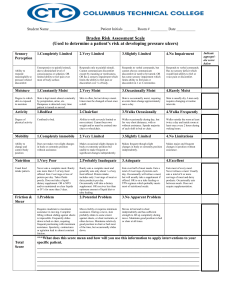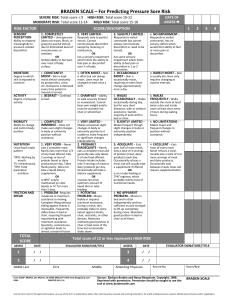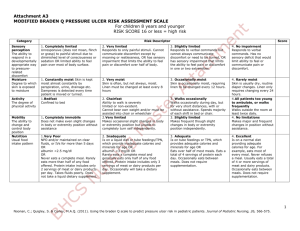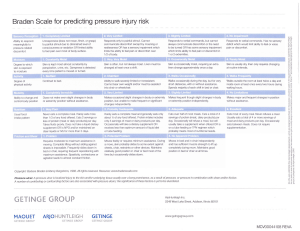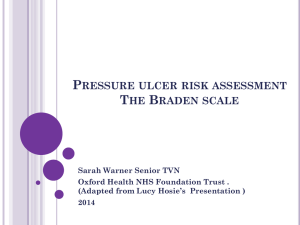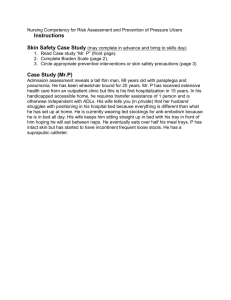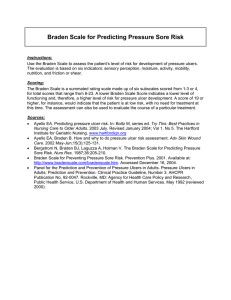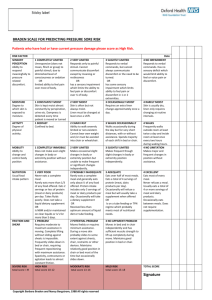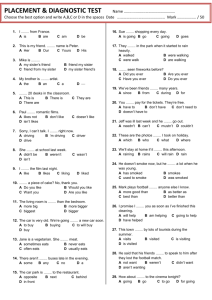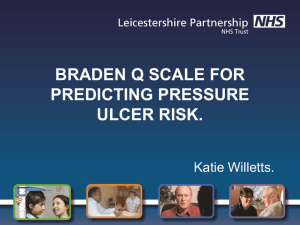Skin Care - Lakeland Care District
advertisement
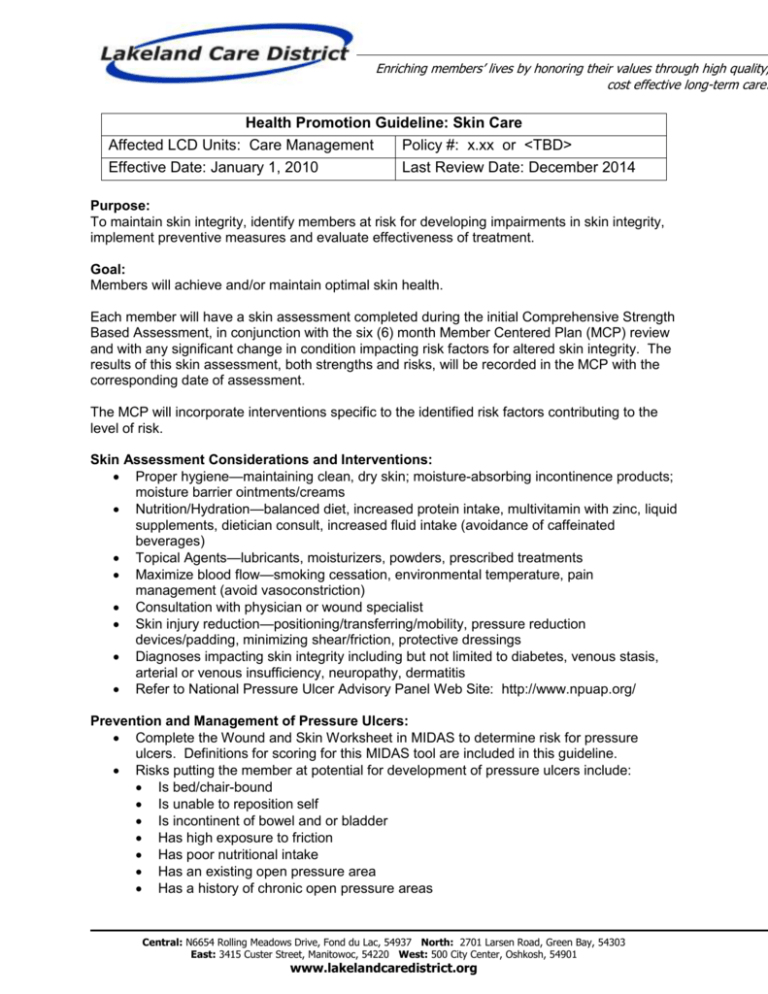
Enriching members’ lives by honoring their values through high quality, cost effective long-term care. Health Promotion Guideline: Skin Care Affected LCD Units: Care Management Policy #: x.xx or <TBD> Effective Date: January 1, 2010 Last Review Date: December 2014 Purpose: To maintain skin integrity, identify members at risk for developing impairments in skin integrity, implement preventive measures and evaluate effectiveness of treatment. Goal: Members will achieve and/or maintain optimal skin health. Each member will have a skin assessment completed during the initial Comprehensive Strength Based Assessment, in conjunction with the six (6) month Member Centered Plan (MCP) review and with any significant change in condition impacting risk factors for altered skin integrity. The results of this skin assessment, both strengths and risks, will be recorded in the MCP with the corresponding date of assessment. The MCP will incorporate interventions specific to the identified risk factors contributing to the level of risk. Skin Assessment Considerations and Interventions: Proper hygiene—maintaining clean, dry skin; moisture-absorbing incontinence products; moisture barrier ointments/creams Nutrition/Hydration—balanced diet, increased protein intake, multivitamin with zinc, liquid supplements, dietician consult, increased fluid intake (avoidance of caffeinated beverages) Topical Agents—lubricants, moisturizers, powders, prescribed treatments Maximize blood flow—smoking cessation, environmental temperature, pain management (avoid vasoconstriction) Consultation with physician or wound specialist Skin injury reduction—positioning/transferring/mobility, pressure reduction devices/padding, minimizing shear/friction, protective dressings Diagnoses impacting skin integrity including but not limited to diabetes, venous stasis, arterial or venous insufficiency, neuropathy, dermatitis Refer to National Pressure Ulcer Advisory Panel Web Site: http://www.npuap.org/ Prevention and Management of Pressure Ulcers: Complete the Wound and Skin Worksheet in MIDAS to determine risk for pressure ulcers. Definitions for scoring for this MIDAS tool are included in this guideline. Risks putting the member at potential for development of pressure ulcers include: Is bed/chair-bound Is unable to reposition self Is incontinent of bowel and or bladder Has high exposure to friction Has poor nutritional intake Has an existing open pressure area Has a history of chronic open pressure areas Central: N6654 Rolling Meadows Drive, Fond du Lac, 54937 North: 2701 Larsen Road, Green Bay, 54303 East: 3415 Custer Street, Manitowoc, 54220 West: 500 City Center, Oshkosh, 54901 www.lakelandcaredistrict.org Guide for MIDAS skin assessment tool Sensory Perception: ability to respond meaningfully to pressure-related discomfort Completely limited=unresponsive to painful stimuli due to diminished level of consciousness/sedation OR limited ability to feel pain over most of the body surface Very limited=responds only to painful stimuli. Cannot communicate discomfort except by moaning or restlessness OR has sensory impairment which limits the ability to feel pain or discomfort over half of body Slightly limited=responds to verbal commands but can’t always communicate discomfort or need to be turned OR has some sensory impairment which limits ability to feel pain or discomfort in 1 or 2 extremities No impairment=responds to verbal commands, has no sensory deficit which would limit ability to feel or voice pain or discomfort Moisture: degree to which skin is exposed to moisture Constantly moist=skin is kept moist almost constantly by perspiration, urine, etc. Dampness is detected every time member is moved or turned Very moist=skin is often, but not always, moist. Linen must be changed at least once per shift Occasionally moist=skin is occasionally moist requiring an extra linen change approximately daily Rarely moist=skin is usually dry. Linen only requires changing at routine intervals. Activity: degree of physical activity Bedfast=confined to bed Chair fast=ability to walk severely limited or non-existent. Can’t bear own weight and/or must be assisted into chair or wheelchair Walks occasionally=walks occasionally during the day but for very short distances with or without assist. Spends the majority of each shift in bed/chair Walks frequently=walks outside the room at least twice daily and inside room at least once every 2 hours during waking hours Mobility: ability to change and control body position Completely immobile=does not make even slight changes in body or extremity position without assistance Very limited=makes occasional slight changes in body or extremity position but unable to make frequent or significant changes independently Slightly limited=makes frequent, though slight, changes in body or extremity position independently No limitation=makes major and frequent changes in position without assistance Nutrition: usual food intake patterns Very poor=never eats a complete meal. Rarely eats more than a third of any food offered. Eats two (2) servings or less of protein (meat/dairy) daily. Takes fluids poorly. Does not take a liquid dietary supplement. OR is NPO and/or maintained on clear liquids for more than 5 days. Probably inadequate=rarely eats a complete meal and generally eats only about half of any food offered. Protein intake includes only three (3) servings of meat or dairy per day. Occasionally will take a dietary supplement. OR receives less than optimum amount of liquid diet or tube feeding. Adequate=eats over half of most meals eats a total of four (4) servings of protein a day. Occasionally will refuse a meal, but will usually take a supplement if offered. Or is on a tube feeding or TPN regimen which probably meets most of nutritional needs. Excellent=eats most of every meal. Never refuses a meal. Usually eats more than four (4) servings of protein daily. Occasionally eats between meals. Does not require supplementation Friction and Sheer: Problem=Requires moderate to maximum assist in moving. Complete lifting without sliding against sheets is impossible. Frequently slides down in bed/chair, requiring frequent repositioning w/ max assist. Spasticity, contractures, or agitation lead to almost constant friction. Potential problem=Moves feebly or requires minimum assistance. During a move skin probably slides to some extent against sheets, chair, restraints, or other devices. Maintains relatively good position in chair/bed most of the time but occasionally slides down. No apparent problem=Moves in bed and in chair independently and has sufficient muscle strength to lift up completely during move. Maintains good position in bed or chair at all times. NOTE: A total score of 16 or less indicates member is at risk of developing pressure ulcers. 15-16=Low Risk; 13-14=Moderate Risk; 12 or less=High Risk. Members with a nutritional score of “very poor” or “probably inadequate” are considered to be at moderate to high risk. Reference: http://www.npuap.org/ http://www.bradenscale.com/images/bradenscale.pdf
